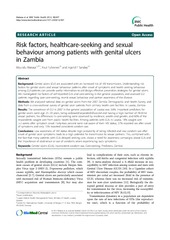| dc.contributor.author | Makasa, Mpundu | en_US |
| dc.contributor.author | Fylkesnes, Knut | en_US |
| dc.contributor.author | Sandøy, Ingvild Fossgard | en_US |
| dc.date.accessioned | 2013-01-18T09:00:03Z | |
| dc.date.available | 2013-01-18T09:00:03Z | |
| dc.date.issued | 2012-06-06 | eng |
| dc.Published | BMC Public Health 2012, 12:407 | eng |
| dc.identifier.issn | 1471-2458 | |
| dc.identifier.uri | https://hdl.handle.net/1956/6273 | |
| dc.description.abstract | Background: Genital ulcers (GU) are associated with an increased risk of HIV transmission. Understanding risk factors for genital ulcers and sexual behaviour patterns after onset of symptoms and health seeking behaviour among GU-patients can provide useful information to aid design effective prevention strategies for genital ulcers. We investigated risk factors of self-reported GUs and care-seeking in the general population, and assessed GU patients regarding past care-seeking, recent sexual behaviour and partner awareness of the disease. Methods: We analysed national data on genital ulcers from the 2007 Zambia Demographic and Health Survey, and data from a cross-sectional survey of genital ulcer patients from primary health care facilities in Lusaka, Zambia. Results: The prevalence of GU in 2007 in the general population of Lusaka was 3.6%. Important predictors for genital ulcers were age 25–29 years, being widowed/separated/divorced and having a high number of life-time sexual partners. No differences in care-seeking were observed by residence, wealth and gender, and 60% of the respondents sought care from public health facilities. Among patients with GUs in Lusaka, 14% sought care >2 weeks after symptom onset. Forty-two percent were not aware of their HIV status, 57% reported sex after onset of symptoms and only 15% reported consistent condom use. Conclusions: Low awareness of HIV status despite high probability of being infected and low condom use after onset of genital ulcer symptoms leads to a high potential for transmission to sexual partners. This, combined with the fact that many patients with GUs delayed seeking care, shows a need for awareness campaigns about GUs and the importance of abstinence or use of condoms when experiencing such symptoms. | en_US |
| dc.language.iso | eng | eng |
| dc.publisher | BioMed Central | eng |
| dc.relation.ispartof | <a href="http://hdl.handle.net/1956/6274" target="blank"> Epidemiological Context of Sexually Transmitted Infections in Zambia: Determinants, aetiological agents and trends over time</a> | eng |
| dc.rights | Attribution CC BY | eng |
| dc.rights.uri | http://creativecommons.org/licenses/by/2.0 | eng |
| dc.title | Risk factors, healthcare-seeking and sexual behaviour among patients with genital ulcers in Zambia | en_US |
| dc.type | Peer reviewed | |
| dc.type | Journal article | |
| dc.description.version | publishedVersion | en_US |
| dc.rights.holder | Copyright 2012 Makasa et al.; licensee BioMed Central Ltd. | |
| dc.identifier.doi | https://doi.org/10.1186/1471-2458-12-407 | |
| dc.identifier.cristin | 941725 | |

